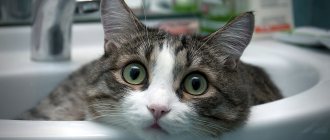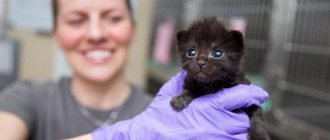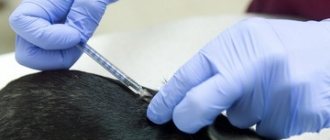In the material, we figured out whether it is necessary to bathe a cat, what determines the frequency of water procedures and when they are contraindicated. After reading the article, you will learn how often adult cats, kittens and purebred cats are bathed.
The washing process is important for your pet and its health. Caring housewives are interested in how often they can bathe their beloved cat. However, the procedure has its own characteristics. The frequency of washing depends on various factors. We will tell you how many times a year you can wash a pregnant cat, as well as a small kitten.
Cats are playful and active creatures. They love to walk outside, climb trees, and interact with other pets. Bathing a cat is a necessary procedure. To keep the animal healthy, the pet needs to be washed periodically. However, the process can become real torture for the owner, because animals do not like bathing.
Bathing a cat
Options for how often you can wash your cat
The frequency and regularity of activities depends on individual factors: some animals need them periodically. Should you wash your cat? The need is often related to long hair, breed characteristics, age and health.
Washable cat
How often to wash a cat
Adult healthy cats that have not been sterilized require more frequent care. Under the influence of hormones, the sebaceous glands of boys produce more secretions, causing rapid contamination of the coat.
How often to wash a kitten
Baby hygiene begins no earlier than 3-4 months. - Until this age, the mother takes care of them. Veterinarians advise starting the first care after baby teeth fall out. Later - from 2 to 4 times a year.
Is it possible to wash a newborn cat? Attempts to bathe the baby at a younger age may lead to the mother refusing to feed due to the foreign odor from the pet shampoo.
Examples depending on the time of year
In winter, the number of procedures is reduced - the animal gets very cold and may catch a cold. In other seasons - depending on pollution or up to 3 times a year, but less is possible.
Do I need to wash my cat extra in hot weather? Experts say that you should not increase the frequency of activities in the summer - this will not save him from overheating, but will only disrupt the functioning of the sebaceous glands.
Depending on the age of the pet
Hygiene is carried out:
- the first - for British kittens and young representatives of other breeds at 3-4 months;
- for sexually mature individuals - 2-4 procedures per year;
- for the elderly - depending on health status.
How often can adult cats be bathed? As needed and as much contamination as possible, especially during estrus, but not more than once every 2 months.
Washing a Scottish cat
Influence of breed and coat length
Why do different breeds require their own grooming schedules? The frequency of washing depends on the length of the coat:
- for short-haired breeds - every 3-6 months;
- long-haired - every 2-4 months;
- sphinxes - it is preferable to wipe with wet wipes, bathe only in the summer heat.
Important! Most often, hygiene procedures are carried out on animals with white, peach and beige colors - every 2-3 months.
Examples of when cats should not be bathed
Water procedures are contraindicated:
- after surgical interventions - care is carried out no earlier than 2 weeks after surgery;
- in the presence of diseases, especially skin diseases;
- immediately after eating - stress will cause a gag reflex;
- A frightened or aggressive cat cannot be washed clean of dirt;
- when the apartment is cold—temperatures below 22 degrees.
Important! Most veterinarians are categorically against water activities for pregnant cats - carelessness can have a disastrous effect on the babies and cause spontaneous abortion.
Rules for washing pets
In order to make the washing process as comfortable as possible for your pet, you need to follow several rules:
- prepare in advance everything you might need;
- remove everything that could fall and break if the cat suddenly breaks out and starts rushing around the bathroom;
- When bathing your pet, act carefully but confidently;
- try not to delay the washing process.
How to train?
It is easiest to accustom kittens to washing, but an adult animal can also get used to water procedures over time. You can help him by following the recommendations of experts:
- act gradually, first give the cat a chance to get used to the bath, then pour some water into it;
- Place a mat or towel on the bottom, as the slippery surface is very annoying for cats;
- minimize stress for the animal, for example, do not take in too much water, do not turn on a strong stream to avoid noise and splashes;
- bathe the cat, constantly talking to him, calming him down;
- If the animal categorically refuses to sit in the water and shows aggression, you should not insist.
How to properly bathe a kitten for the first time?
It is very important to properly conduct the kitten’s first bath, since it will largely determine its future attitude to water procedures. To prevent your baby from being frightened by a large amount of water, it is better to use a basin with a towel on the bottom. The water should reach the kitten's belly; there is no need to pour more.
You shouldn’t involve many people in the process; you can wash the baby alone, and the kitten will feel calmer without spectators. After washing, you can treat your pet with a treat so that in the future washing will be associated with something pleasant.
Optimal water temperature
The normal body temperature of cats is about +38⁰С. Bathing water should be 1-2 degrees warmer. Over time, you will be able to determine the temperature by hand, but the first few times it is better to use a thermometer.
Features of washing cats in winter
Veterinarians strongly do not recommend bathing cats in winter. Firstly, the temperature in the bathroom in winter may not be high enough and the cat will freeze while in the water.
Wet cat
And besides, after washing the animal is rarely able to dry thoroughly, so for some time the pet walks around the house with wet fur. In this case, the slightest draft can cause a cold. If necessary, in winter you can use dry shampoo, which does not require moisturizing the coat.
Circumstances for washing a cat
There is no need to force an animal without special prerequisites. The process is stressful for most pets and it is not worth causing them excessive nervousness - hygiene can cause behavioral disturbances.
Heavy pollution
How often can you wash your dog and puppy with shampoo?
Should pet cats be washed if they look dirty? The prerequisites for care activities are:
- increased soiling of wool and its matting - due to the active production of sebum;
- period of hormonal imbalance during sexual heat - the pet rolls on any surface, collecting dirt;
- accidental ingestion of fatty, oily substances that the cat cannot remove on its own.
Presence of parasites
If blood-sucking parasites are detected, washing is carried out with special insecticidal zoo shampoos. They help quickly get rid of fleas and prevent scratching of the skin when bitten. In case of severe infection, the procedure is carried out twice.
Important! Additional treatment involves the use of anti-parasite sprays or drops, which are left for 24-48 hours, after which the pet is bathed again.
Particular attention is paid to the British - they often suffer from allergies, and medications must be selected for them by a veterinarian.
Before exhibitions and competitions
Is it possible to bathe cats before an exhibition or competition? Participation in exhibition events requires the ideal condition of the coat. On the eve of the competition, zoo shampoos are used to give the cover shine and silkiness. The wool is combed, applied with gel and varnish.
Another interesting question: is it possible to wash a purebred cat with human herbal shampoo? Experts are unanimous on this issue - the use of inappropriate care products can cause massive hair loss and partial baldness of the pet. Injured animals are not allowed to exhibit.
Spray shampoo
Once for a certain period
Some owners set their own schedule for hygiene procedures and, for example, prefer to carry them out once a quarter, on a certain day. This approach allows you to avoid problems with the sebaceous glands and drying out your pet’s skin.
Important! Using tar or laundry soap can cause dermatoses and rashes, and dulling of the coat. Animals are not suitable for human remedies.
Is it possible to wash a cat after giving birth?
Should cats be washed during the postpartum period? You should not bathe a nursing animal without objective reasons:
- getting oils and fuel oil on the fur;
- accidental contact with fresh paint;
- damage by blood-sucking parasites.
Cleaning-induced stress can affect the quantity and quality of breast milk in both British and non-bred mothers. The owner will have to switch to artificial feeding of the babies.
When is it not permissible to wash cats?
There are several contraindications for bathing cats:
- the animal is scared or aggressive;
- the pet has recently experienced severe stress;
- the cat has recently had surgery (you must wait at least two weeks);
- the animal is sick or has significant skin damage.
You should also not bathe your cat immediately after eating.
If your pet has fleas or lice that cause it to constantly itch, in order to avoid intoxication of the pet, you should not wash it frequently with anti-flea shampoo.
Preparing a cat for a bath
Fish for cats - examples of what is and is not possible
Preliminary preparations include:
- nail trimming;
- combing and trimming clumps of stray hair;
- selection of a suitable place - for large individuals a bath is suitable, for children - a basin or washbasin;
- removing all foreign objects - washcloths, cans of hair and skin care products.
Special shampoo for cats
To wash an animal you will need:
- cat zoo shampoo;
- cotton swabs or a special cap covering the ears - used for all breeds, including Scottish Fold;
- soft sponge - for the head;
- large terry towel - for drying after a bath;
- a small towel - for final drying of the wool.
Preparing the owner for bathing the pet
Experienced breeders advise carrying out hygiene measures together - this makes it easier to cope with possible resistance from the pet.
To wash the cat, one will have to hold the animal, the second will do the soaping and rinsing off the foam. Owners do not need special training, but when washing cats that are aggressive and hate water, you can stock up on antiseptic and adhesive tape to disinfect scratches.
Drying wool after bathing
After washing, take a towel and gently blot the animal's fur with it. Wring it out, wrap the cat in a towel and wipe with light massaging movements. When it gets very wet, take another dry towel and wrap your pet in it.
After this, the cat can be taken out of the bath and placed on a dry towel. Make sure that the balcony and windows are closed. If the cat has long hair, you can brush the fur until it dries. The procedure will not only speed up drying, but will also make it easy to get rid of knots if they appeared during the washing process. It is better not to use a hairdryer.
Praise the cat
After bathing, be sure to praise the cat, pet him, and tell him how good he is. Give a favorite treat, catnip, or another treat that you rarely give on special occasions. If your cat associates washing with a reward, he will be more willing to bathe.
Choosing a bathing temperature
Is it possible to feed a cat both dry and wet food at the same time: examples of mixing
Before holding events, you need to pay attention to the following points:
- how many degrees in the room - in the bathroom and the room where the cat will dry, it should be at least 22 degrees;
- water - from 38 to 40 degrees, depending on the breed.
You can determine the comfort of the temperature by looking at your pet - if he is shaking with chills, then he is cold. Too hot water can cause serious burns to delicate skin; its readings should not exceed 40 degrees.
What you need to bathe cats
Human shampoos are not suitable for washing. The pH of human and cat skin is different. The wrong cleanser can lead to dry skin, dandruff and even ulcers.
To bathe, you must purchase a special shampoo for cats in advance. If your pet has fleas, the detergent should have an antiparasitic effect.
Water temperature is about 37 C°. You will also need two towels to catch the water from the wool.
If your animal is terribly afraid of water, it is better to buy dry shampoo. The powder is applied to the coat and then combed out. It will collect dirt and grease, and also maintain friendship between the cat and the person.
Short-haired cats can be wiped with a wet towel. It will remove dirt and loose hair.
Choosing a Shampoo
Veterinary pharmaceuticals produce a sufficient amount of products intended for the care of cat fur. In addition to the usual liquid varieties, you can use dry powders, sprays, foams and mousses. Products that do not require the use of water are suitable for animals that do not tolerate water treatments well.
Liquid
They are among the most popular among owners of four-legged pets. The convenient consistency speeds up the process - provided that the cat does not resist washing. Liquid pet shampoos have the best characteristics:
- they easily remove greasy deposits;
- get rid of difficult-to-remove contaminants;
- Gives wool shine and silkiness.
The disadvantages of use include the possibility of drying out the skin if washed too often. Among the variety of options, you can choose the perfect one for each pet:
- Api-San Velvet care;
- 8 in 1 Perfect Coat Shed Control and Hairball Shampoo;
- Rolf Club - against ticks and parasites;
- Lugovoy - against parasites and dry skin;
- Doctor ZOO.
Dry
Used for short-haired cats afraid of water during exhibitions. The line includes:
- Tropiclean Dander Reducing;
- Dry Powder Shampoo;
- Perfect Coat Freshening Foam;
- Trixie Trocken Shampoo.
Sprays
They have antistatic effects and are suitable for long-haired cats. After use, they do not require rinsing.
- Waterless Cat Shampoo Spray;
- FURminator - from tangles;
- Doctor VIC for dogs and cats.
Important! This type of grooming product is not suitable for all animals - many are scared by the sound of the aerosol.
When is swimming contraindicated?
It happens that bathing a pet is prohibited. It is important to know the contraindications when you can’t wash your cat?
Vaccinations
You should not wash your cat before vaccination.
When your baby needs vaccinations, you need to know some things about washing. You cannot bathe the animal before vaccination, because... They are done only on dry skin. It is worth holding off on the procedure or rescheduling your visit to the doctor to another day, when the baby’s coat is dry.
After vaccination, it is forbidden to wash the animal for 5-7 days, and sometimes for two weeks. However, all situations are individual. Ask your doctor for advice on when and how often to bathe.
Pregnancy
Carrying children is a lot of stress for a cat. A mother gives all her energy and strength to her babies. Animals do not like to bathe and experience fear during the procedure. It is not recommended to bathe a pregnant cat to avoid stress. On the contrary, it is worth creating comfortable conditions and a calm environment for her.
It is not recommended to wash a pregnant cat
After giving birth, you should also not wash the animal for a while. If the cat gets dirty, you can wipe the body with wet wipes or a wet towel.
Sterilization
After sterilization, you should take a break and not bathe your cat for one week, because... there are seams. It is advisable to ask your veterinarian when you can resume bathing procedures.
It is not advisable to bathe sterilized cats.
Diseases
If your pet is sick or not feeling well, do not allow situations in which the animal feels stressed. Wet skin prevents wounds from healing.
Exception: sometimes during illness a pet develops different discharge. Then you will have to bathe the sick baby.
Rules for applying and washing off products
When using dry powder, just apply it, rub it into the undercoat in a circular motion, and then comb the animal. Before the event, it is better to spread a cloth or oilcloth to easily collect the powder.
Washing with a standard product requires first wetting the cat's fur, except for the area of the ears and eyes. Then apply zoo shampoo, foam and rinse thoroughly.
The spray shampoo does not require removal; after uniform application, the pet is combed out.
Rinse off shampoo
Is it possible to touch the head and ears?
You need to wet your pet's head with caution. Often water and foam get into the eyes and ears, causing discomfort. You need to make sure this doesn't happen. Failure to comply with such precautions often leads to various diseases (otitis media, conjunctivitis and others), which can develop into even more serious health problems for the pet.
You can wash your cat's head and ears, nothing bad will happen
But you shouldn’t be afraid, because washing your hair is as important and quite a simple process as general bathing. You need to soap the top of your head, you can carefully apply shampoo to the area under the ears, but only so that moisture does not get into the ear canals!
You shouldn’t wash your face; it would be better to wipe your cheeks, bridge of your nose, forehead and chin well with a damp cloth or just a wet hand.
While moisturizing your head, you need to protect your ears. To do this, you can use comfortable plugs or cover with your finger. After washing, wipe the inside of the ear with a cotton pad and clean the ear canals. Also wipe your eyes with a dry cloth.
If, while bathing, the cat suddenly suddenly begins to shake its head, snort or squint hard, it means that water has got into undesirable places. If the nostrils are wet, you need to let your pet cough and snort, carefully monitoring his breathing. Usually, within a couple of minutes the sneezing goes away and you can continue bathing. The same goes for water getting into your ears. Washing is suspended until the cat shakes out the water.
However, if the cat continues to be bothered by this kind of discomfort, especially after bathing, it is necessary to thoroughly dry the pet, limit its presence in cool places and monitor its health. It is better to contact a veterinarian in the following cases:
- the cat is restless and absent-minded;
- shakes his head frequently;
- rubs ears, eyes with paw;
- tilts his head to the side;
- sneezes, coughs;
- eyes water;
- the eyes are red (noticeable if you pull back the lower eyelid a little and look at the mucous membranes, also examine the whites of the eyes);
- the inner side of the auricle in the depths is hyperemic (reddened);
- there was discharge from the ears;
- discharge from the eyes.
If you notice at least one or two of these symptoms, you should not postpone a visit to the veterinary clinic. It's better to be safe than to miss a problem at an early stage.
Drying the animal
The freshly washed cat, wrapped in a bath towel, is carried into the room. For long-haired breeds, you may need another towel if the first one gets wet and stops collecting moisture. If the animal is not afraid of the sound of a working hair dryer, then 10 minutes after washing you can start drying. The device regulator is set to warm air - too hot can burn delicate skin.
The next step is to carefully comb the fur and untangle any tangled areas. After water activities, the cat should stay in a warm room for at least 1 hour - otherwise it will catch a cold.
Should cats be washed? This is an interesting question to which not everyone knows the answer. Hygiene measures are often unpleasant for both the pet and its owner. But sometimes it is impossible to do without them. Compliance with washing rules will reduce discomfort in the animal and prevent stress. After each bath, your furry pet should be treated to a special treat for cats - it will calm him down and increase the level of trust in his owner.
How to wash a cat if she is afraid of water or bathes for the first time
What could be worse than bathing for a cat? The only thing scarier is swimming for the first time. Unusual surroundings, sounds, sensations, the procedure itself - all this is a lot of stress. Therefore, a cat can break out, bite and scratch, even if such behavior is unusual for it.
The first bath is best done together. One person holds the cat, the second one washes it. This way you can not only protect yourself, but also wash much faster.
While bathing, you need to talk to your cat in a calm and gentle voice, call him by his nickname, and praise him. After water treatments, it is not advisable to dry your cat with a hairdryer. The sound of a hair dryer can frighten the animal even more. At the end, be sure to give your cat a treat and praise her.
Regular shampoo or special: what to choose
photo from website: PipCat.ru
If you preferred what you wash your hair with, we hasten to disappoint you - products intended for people are absolutely unsuitable for cats. The reason is a different acid-base balance, the risk of allergies and deterioration of the animal’s skin condition.
Some people use regular soap. Veterinarians prohibit resorting to such radical measures. The consequences of bathing a cat this way are:
- dry skin;
- hard wool;
- dermatitis as a reaction to the aggressive effects of substances contained in soap or shampoo;
- the appearance of dandruff.
It is better to choose cosmetics for tailed and mustachioed animals at a pet store. On their shelves there are different types of products: dry, liquid, sprays. The seller will help you choose the best option.
We repeat once again for those who are still wondering whether it is possible to bathe cats with regular shampoo, and are already reaching for their own Timotei or Pantene to use it for the best purposes - give up this idea. Don't skimp on your pet. A stingy person pays twice - the second time for the services of a veterinarian who will treat your cat for allergies or look for the cause of dandruff.
When the cat needs to be washed
photo from the site: nashsovetik.ru
If you still had to arm yourself with washcloths, brushes and other bathing equipment, you need to know how to do it correctly so that the cat does not return from the bath angry with the whole world and scared to the point of nervous trembling, and you - crippled and deafened by frantic meowing.
Yes, bathing is a stressful situation for a cat. But in some cases it cannot be avoided. For example, if you took your pet with you to the dacha, and there he played enough, simultaneously collecting all the garden dirt. Or if you urgently need to prepare your beloved furry beauty for an exhibition.
And cats are not that clean, because over time the fur sticks together and gets dirty, and in long-haired Persians or Maine Coons, tangles often form. There may even be an unpleasant smell, so you shouldn’t hope that Vaska will do everything himself, without outside help.
Should domestic cats be bathed? Necessary. Veterinarians advise doing this if:
- The pet has fleas and other ectoparasites on its body.
- The cat is dirty - this can be seen with the naked eye.
- For prevention purposes - for example, if your animal has sensitive skin prone to dermatitis, and the shampoo is medicinal.
To wash or not to wash
In order to understand whether a cat can be washed, it is important to know that not all dirt can be removed by them on their own. A water procedure should only be carried out in exceptional cases - before going to an exhibition or seeing a doctor. also need to bathe the animal occasionally if there are children in the house who will play with the cat. Additionally, those pets who have to fight fleas and other parasites that affect the skin or coat will have to undergo this test.
© shutterstock
For this purpose, not only water is used, but also special hygiene products - shampoos, which contain special agents to influence parasites. In addition, cats that spend a lot of time outside cannot avoid washing. It is best to purchase shampoos for washing cats in pet stores or veterinary clinics, since they undergo strict control there; the owner will be confident that he will not harm the pet by using a hygiene product during the bathing process.
Is it possible to bathe a cat during heat?
You can bathe a cat during a difficult period of estrus; the procedure will not harm her. Moreover, some owners have noticed that after bathing their pets are so busy licking that they even calm down for a while. But this does not mean that water procedures can be performed every day. They resort to them only once.
Bathing during heat distracts the cat.
Bathing and shedding
During the seasonal coat change, the cat grooms itself with special care, trying to collect all the falling hairs from the coat. The pet swallows the fur, which collects in the stomach into a dense lump. Some cats “delight” their owners by regurgitating fur onto their favorite carpet - this is the best, but not ideal, option. It’s worse when the cat for some reason does not regurgitate its fur, suffering from heaviness in the stomach, difficult digestion, and in rare cases even from intestinal obstruction. Bathing speeds up the shedding process, as water and mechanical manipulation help remove dying hairs. But it is worth asking the breeder how often cats can be washed during shedding: some breeds lose too much hair, upsetting owners with bald spots on their sides (all Rexes, some Siamese and Orientals). “Teddy”, long-haired and short-haired cats with a normally developed undercoat are not at risk of baldness due to bathing.
Where to go in Moscow?
- Fluffy happiness. Addresses:
- N. Cheryomushki, st. Garibaldi, 15.
- st. Kastanaevskaya, 17.
In addition to highly qualified groomers, a veterinary office is open here twice a week. There is a large selection of accessories, clothing and pet comfort products.
- Chain of pet salons Baluti.
Addresses of pet salons:
- M. Kuntsevo, Kastanaevskaya, 58.
- m. Marksistskaya, Ryazansky Ave.
- m. Varshavskaya.
- m. Tulskaya.
- m. Shchelkovskaya.
In salons there are discounts on services for kittens, check with the administrator. There is also a late appointment for busy people, but be careful, the cost of procedures will be increased by 50%.
In addition, there is a service to call a master groomer to your home. If you have a long-haired cat, you can handle it yourself - just read our article .
Watch the video: MY CAT - See how to do it correctly
How to train a cat to use the bathroom?
Some owners of furry four-legged animals approach bathing their beloved cat with excessive fanaticism. They wash the animal almost every day, without even thinking about whether it is possible to do it so often. Of course, a “bathhouse” will undoubtedly benefit the cat if the entire bathing procedure is carried out as it should, with the correct frequency, while observing certain subtleties.
In principle, no special knowledge is required on how to wash a cat. The most important thing is to accustom your pet to the bath in early childhood. The first bath of a one-year-old animal can result in not only scratched and bitten hands for the owners, but also extreme stress. It is quite difficult to restrain a kicking cat who is screaming in a voice that is not his own, constantly breaking out. In such cases, the pet is washed by the whole family - one person cannot cope with a raging cat.
How and when to wash a kitten for the first time and with what?
Unless there are any special circumstances, a mother cat successfully cares for her babies, including their fur. In the first month from birth, healthy kittens do not need bathing.
You need to wash your kitten for the first time at the age of 3-4 months.
IMPORTANT: Veterinarians advise giving a kitten a bath for the first time at the age of 3-4 months.
It is not recommended to bathe younger kittens because:
- baby may get scared
- if he's with his mom, she might not recognize him as smelling like shampoo
- The baby has not yet established thermoregulation, he may freeze and get sick
IMPORTANT: Kittens that have been vaccinated should not be bathed for 10-14 days.
So, the decision was made to wash the kitten. What's the best way to do this?
- The procedure should be carried out 2 hours after feeding the kitten.
- It is necessary to prepare the bathing area so that cat shampoo and two terry towels are at hand. How to choose a shampoo can be read below.
- It is better to bathe a kitten not in the bathtub, but in the sink and basin. Lay a terry towel or cotton sheet on the bottom.
- Approximately 5 cm of water is collected in a sink or basin. Her temperature is measured. 38 degrees is the optimal indicator.
- It is better to turn off the tap while bathing the kitten; the noise of the water may frighten it. You can wash off the shampoo with a ladle or a mug. If the wool is dense, it can only be washed with running water; the stream from the tap or shower should not be under high pressure.
- The kitten should not be immersed in water abruptly, starting with its hind legs. At the same time, it is important to stroke him and calm him down.
- Perhaps, like a child, a kitten will tolerate bathing more easily if it has balls and toys - squeakers - that will distract it from the unpleasant procedure.
- You need to water the kitten's body very carefully, making sure that water does not get into the eyes and ears. The shampoo should be rinsed off the fur thoroughly.
- After bathing, the baby should be wrapped in a towel to prevent him from freezing. When the towel gets wet, it should be replaced.
- Dry the kitten's fur with a soft brush or hairdryer if he is not afraid of it.
To calm your kitten while bathing, you need to talk to him. Your pet's favorite toy will also help.
IMPORTANT: The success of subsequent baths largely depends on the kitten’s first bath. If it went smoothly, the adult animal will treat the procedure calmly and indifferently. If the baby has experienced stress, in the bath he will be a real demon, which will be difficult to cope with even together.
Important tips for choosing a bath for cats
- Use cat shampoo : To clean your cat's fur, cat shampoo is best. It will cleanse your cat's skin and fur without disturbing it. Any hard soap is bad for him. You can try another method if your cat shampoo has run out or is not available at the moment.
- Be Bath Friendly : Don't be harsh on your cat if she acts crazy during bath time. Stay calm as this is important for an easy bath. That's why try to remain friendly with him.
- Do not use a thin brush : during the bath, the hair roots become soft. A thin brush will pull out these hairs by the roots. Instead of using a brush, give her hair a good rub with your hand.
- Dry faster : Domestic cats are too sensitive. Instant drying is too important for these pets. For instant drying, you will need a hair dryer with medium-high air flow.











